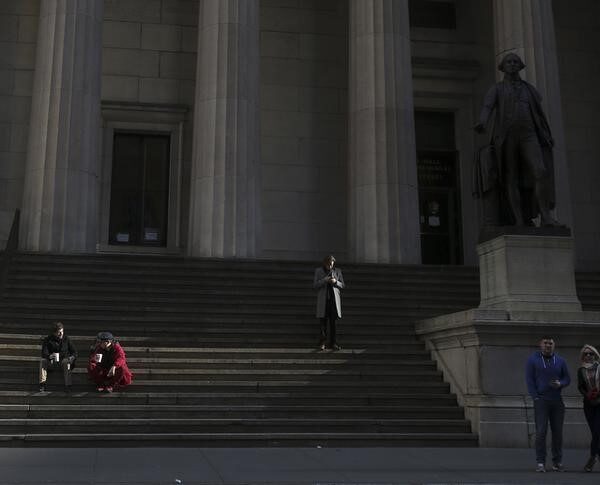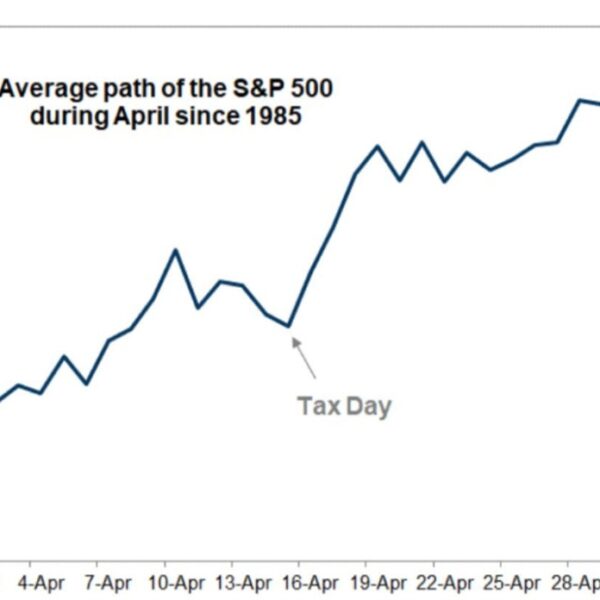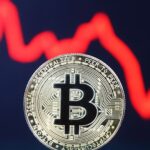Fokusiert/iStock via Getty Images
Listen here or on the go via Apple Podcasts and Spotify
Fed Trader Chaim Siegel talks market building blocks to keep investors sane (1:00). Inflation, TLT, bond yields and treasury market (11:00). How recent earnings figure into macro picture (15:05). Nvidia upside and AI hype (17:40). Tesla bearishness; negative sentiment (27:05). Thoughts on geopolitics, oil and the energy sector (35:20). Gold and bitcoin (38:55).
Transcript
Rena Sherbill: Chaim Siegel, welcome back to Investing Experts. It’s always great to have you on Seeking Alpha. Thanks for making the time and talking to us.
Chaim Siegel: My pleasure. Thank you, Rena.
RS: Yes, it’s a pleasure to have you on. You’ve been on before. The listeners know you. You run Fed Trader. Oftentimes, you’re on here talking about macro topics. Sometimes, you’re on here talking about stock-specific topics.
Here we are in the, almost the middle of the year. We’re in the middle of May 2024. You were talking about how you were going to be bullish with some caveats at the very beginning of — or at the end of last year, you were talking about this year. How are you thinking about the markets based on how you were seeing them previously, and how are you thinking about them currently?
CS: Yeah. So, thank you for having me. It’s always a pleasure. I just want to backtrack, and I don’t think I’m doing something so fancy or anything. I think I’m just doing basic pro-trader look at the market, markets moving up, markets moving down, and keeping things simple based on a few simple data and facts that I constantly follow. And sometimes, I feel like the market gets swayed by the media or different news.
And I think that there’s a couple of building blocks. I’m just getting to your question, a couple of building blocks that can keep you sane in following the market and not get you crazy. One is fundamentals. Two is technicals. And maybe under technicals, or maybe its own category, I call action. So, fundamentals, are earnings moving up? Is the economy doing well, right? That’s its own thing. Is the Fed getting in the way or not? Or is the Fed letting the economy go? That’s all called fundamentals, right?
And, fundamentals, I think, are good, right? The economy is good. The Fed is not getting in the way and therefore, earnings are good.
I was bearish on 2022. I flipped at the end of 2022 ahead of the big market run in 2023, getting bullish when I saw everybody was worried about recession, but I wasn’t, not that I’m a great prognosticator. I just like looking at the data and saying what’s going on now and I’m momentum oriented.
So, whatever is going on now, I believe that that can continue. I mean, I don’t think we have many better indicators than just assessing what’s going on now, and is it realistic, it could continue. So, I saw that jobs were very strong at the end of 2022. And I said everybody is bearish, jobs are fine. I’m bullish. And the market had a good year.
And coming into this year, I did see a couple of like geopolitics and maybe the Fed, mainly geopolitics as one of the big headwinds. Potentially, that could cause some bumps, but, I guess, as I saw that underlying fundamentals were good, the Fed wasn’t getting in the way of the market by not hiking and staying in a — they were really staying in a cutting stance even though they’re not cutting, they think they’re cutting, but they’re not cutting.
And so, the fundamental part is bullish. Technicals have been bullish. And action, which is basically measuring just how the stocks act, meaning are they volatile or not has been bullish.
I mean, stocks when they trade 0.5% or 1% every day up or down, that’s bullish. If it traded wild 3% or 5% up and down, that’s bearish. And that’s a hint for what the underlying trend is from traders and investors that are pushing the market. So, overall, things are bullish, and I think that the year can finish bullish. There’s other things I’m watching, but for now, it looks like it should continue to be bullish.
RS: What are some of the other things you’re watching?
CS: So, CPI just came out 0.3% yesterday. I think that’s a little bit of a perfect number for the market, because it keeps the Fed flatfooted. It means that there’s inflation, and it means that the Fed can’t hike.
So, inflation is not bad for the market. Inflation is only bad if it causes the Fed to hike a lot. Because if the Fed hikes a lot, then the market says, “Uh-oh, there’s going to be competition in the bond front or in the short-end market. I can get 5%, 6%, maybe more in the short end. Why do I need to invest in stocks and money comes out of stocks and goes into short-term instruments?
So, Fed hiking is negative for the market. But if the CPI is 0.3%, you have inflation, but the Fed still thinks that they’re going to cut, and they think that inflation is coming down. I think they’re wrong, right? I don’t think inflation is coming down, but we have 30 days to figure that out.
And in the meantime, me being momentum, I think whatever is the trend, unless you have something major that’s working against that trend, equal and opposite force like in physics, then the trend is the same thing. So, the CPI at 0.3% is fine, but I don’t think the CPI will stay at 0.3%.
The Fed is saying, “Oh, housing has to drop soon.” But the Fed is fighting inflation, and they just said that they’re going to slow down their quantitative tightening. Quantitative tightening means that, they are reducing their balance sheet from owning all sorts of fixed income securities. If they’re reducing their balance sheet, that means that they are going to buy less in the open – so to speak, the open market from the government.
So, the government has this huge buyer going away in the market. And when you have a huge buyer going away, that means that there will be price pressure in the market. So, bonds and notes and everything fixed income should have pressure.
And we’ve seen — I look at (TLT) every day and for subscribers, and TLT has been going down. And quantitative tightening means that the big government manipulator of the fixed income market, the Fed is out of — is trying to get out of the market. Now, even though they’re fighting inflation, they said that we’re going to cut quantitative tightening, meaning we are going to buy more bonds in the market.
When a big — when this giant actor in the market, and I do think manipulator in the market, that’s what they’re designed for, comes in to buy more bonds because they want to reduce their portfolio less, so as bonds mature in their portfolio, they’ll — when they reduce quantitative tightening, that means they’ll be buying more maturing securities back, meaning they’ll be in the market more.
As they’re in the market more, they’ll support prices of all these fixed income securities. And when they support prices, that means the prices will go up. Interest rates across the yield curve generally would come down more than otherwise. And as they come down, it allows more growth. If it allows more growth, it allows inflation to keep going.
So, even though that the Fed says, “No, we’re focused on cutting inflation,” it really makes no sense to me that if you’re cutting inflation, why would you slow quantitative tightening. And so, the fact that they’re slowing it means that I think that they’re allowing inflation to percolate.
I think inflation is something that — obviously, the word inflation means prices are going up, and prices going up can be good for Bitcoin prices and stock prices, and any prices in the supermarket, any prices, it means prices generally all go up together. So, that’s good for the market.
And so, that’s why 0.3% and inflation is good for the market, but when you start getting 0.4% or 0.5% or 0.6% CPI, then the Fed’s going to say, “Uh-oh, we’re losing our handle or our grip on inflation,” and they’re going to want to start hiking rates. And if they start hiking rates, it’s going to kill the market.
So, as long as we’re in this in between 0.3%, I think the market is fine, but if the CPI skips up to 0.5% and 0.6%, especially since the Fed and the market all believe that inflation is coming down and there’s going to be cuts, I think it’s going to be a big surprise for the market.
So, it takes time for the Fed to adjust. And I’ve been saying to the subscribers, they are pivoting to neutral, but they’re still talking cuts. And as long as you’re in an inflation period, which we are, and they’re still considering cuts, they have a few moves, which each move takes a few months before they get to the next pivot and the next pivot.
The next pivot would be to neutral, and then a pivot after that would be to hike, and then they’d actually hike. So, you see, like, you have six months of moves before the Fed actually does anything.
And so, if inflation is percolating because the Fed is pushing inflation because they’re being stimulative because they’re cutting quantitative tightening, then you could see six months out that they’re going to start to need to take — I believe inflation can start or continue to start — continue to move back up, and then that’ll force the Fed to cut, which will hit markets.
But in this in-between stage and the window — we have headlights in front of us before they actually change their stance and before they would — and when they change their stance before they actually move on that changed stance, the market has a window of inflation, which is good for stock prices as it is for all prices.
RS: And how would you advise or encourage investors to be thinking about the bond and the treasury markets as we watch this macro picture unfold?
CS: So, I watch TLT all day — every day, not all day, but every day.
RS: TLT and chill?
CS: Yeah. I do have a life. So, I just stare at TLT all day. That’s my life. No. TLT is a major driver to the market.
Bond yields — I mean, look, there’s — the discounted cash flow pricing model, which I learned a million years ago in college, and I think underlying stock values are directly affected by the medium/long-term interest rate because people can look up DCF, discounted cash flow model, on the Internet, I don’t need to explain it, but I believe stock prices are very affected by interest rates, obviously.
And as interest rates go up, stock prices, in college class, go down. And if interest rates come down and in college class, stock prices go up. Obviously, there are other forces in there, but that’s the main thing.
So, where I think that you have two — on bonds, you have two different forces. One is the Feds in there buying more. And as long as inflation doesn’t go up, then obviously bond prices should go up, because you have a bigger buyer and you don’t have the fundamentals getting worse. Bonds hate inflation.
Why? Because if I’m only getting 3% and everything is going to be worth less in the future, I don’t want to hold bonds if inflation is high. So, people sell bonds if there’s high inflation, because they want a higher interest rate to pay for — to keep pace with their depleting value of their currency, because, as things cost more, that means the value of currency is worth less. So, you need more — a higher interest rate to offset that degradation of the currency value.
So, if inflation is tame and the Fed is changing and their buying more, then bonds should go up, and that’s good for the market, but if inflation is moving up because the Fed is buying more, like I just explained previously, then I think that’s a negative for bonds itself even though you have a bigger buyer in there, the Fed, because, people will demand higher interest rates on their bonds to pay for the depleting value of their currency based on inflation.
So, I think watching inflation itself and seeing how stocks react as bonds react to inflation is very important. So, like I said early, like my opening introduction, that I watch action as the like a third measure. And so, if stocks are going up and down 0.5%, 1%, S&P (SPY) and (QQQ)s going up within 1%. I think that’s a very bullish market and we’ve seen that.
But if you see that you have a bad CPI number 0.5, 0.6, whatever, at some time in the future, and you see bonds break and that breaks the market, 3%, 5% and another day, 3%, 5%, maybe the markets change then.
And, we’re looking at short-term trends also technically, medium-term trends, and to see if generally the trends changed. I mean, the market looks good now. I mean, trends up, obviously up. It’s hitting new highs, and so everything’s fine. And like, I said, inflation is not a problem, but I believe the Fed’s move is — will cause an inflation problem probably in, three to six – call it, six months.
RS: And how does the recent earnings that we’ve seen, broadly speaking, figure into your thoughts here?
CS: Yeah. Great question. So, obviously, the market is a collection of stocks, and stocks are driven based on earnings. So, I mean, earnings really, really are the most important driver to stocks themselves. And, I think the Fed overall is the driver — is one of the key — they can’t be a key driver to the market, but they don’t always have to be. And if they’re not, if they’re not in the picture of shaking trees, then the main thing is our earnings because that’s driving the stock prices, which is driving the market.
And earnings have been good, I mean, earnings generally have been beating.
And I mean, I follow a few specific stocks. I follow Nvidia (NASDAQ:NVDA). I follow Micron (MU) because I think Micron is probably the most important stock always in the history of my 30 years in the business. Micron is the most important stock for the investing world. People don’t know that I can explain that. I follow Tesla (NASDAQ:TSLA). I follow Microsoft (MSFT), Amazon (AMZN). I picked up coverage of Super Micro (SMCI) because after the big drop, I like that. And I follow Apple (AAPL), Microsoft.
So, I’m following specific stocks. And generally, everybody – mostly people are – mostly, companies are bullish. I think the only negative fundamentals I’ve seen are in Tesla and Apple, as far as the stocks that I’m following, but Nvidia, I mean, I have, blowout earnings. My earnings are way higher than the Street. Micron, Supermicro, and some CI. I mean, my numbers are way higher than the Street. Amazon, I have numbers way higher than the Street.
So, I mean, I think, and when I have a lot of buys, I call them bullish ratings. That usually is a good sign for the market. So, my bottoms up is matching my top down, I guess.
RS: Incidentally, for those wondering about Chaim’s thoughts on Micron and why it’s such a salient stock to follow and why it gives you hints about what the market’s doing, I think that was our first conversation that we had you explained us, so I’ll leave a link to that in our show notes for anyone interested.
CS: Okay. Great.
RS: I’m curious, you mentioned Nvidia that’s an obvious marker of the tech sector, a sector that’s been doing quite well. How are you thinking about the tech stocks these days, and how much upside there’s still left there?
CS: Okay. Great. So, look, everybody’s talking about AI, and I’m hearing also in the market, which is very healthy that AI is overhyped and that’s fine. I mean, I’ve been in the business 30 years, so I actually got my start when internet was starting its boom in the market. And I remember there were tons of companies without real revenues and without real earnings getting multiples. And it was not sustainable. So, this is not that market.
This is not the dot-com boom. This is companies, I mean, maybe in the private equity sector, which I don’t follow, but we’re in the stock market and everything in the stock market for the most part, has a lot of – there’s a lot of fair value, meaning companies have earnings and companies are being valued on those earnings, unlike what was in the dot-com boom, which was a lot of, hype.
I respect it because after the dot-com boom, left a few, quality players that, and the internet came to be something. Now AI, there’s not a lot of great, I think there’s few, compared to the dot-com boom, there’s only a few ways to really expose yourself to AI.
And one is Nvidia. I mean, I think, there was a politician claimed, he invented the Internet. I think, but – and that was a little bit of a joke, but Nvidia did invent AI. I mean, their technology on how they went to a GPU changed the face of technology. I mean, I’ve been following Nvidia for years, and there’s nobody that I heard speak about AI for, as long as Nvidia has. I mean, I can remember back 10 years maybe, maybe more, that they’ve been talking about AI being a core driver to their business.
And what’s AI? It’s that you have computing power that allows the computer to basically learn and think for itself, so to speak. And so, based on the computing power that Nvidia’s developed, they — so to speak, unlike the ex-politician, did invent AI, and they are, and everybody, I remember when (AMD) and Nvidia were making normal chips for computers and all the hyperscalers were trying to copy them.
And I’ve been hearing this for years and nobody — none of the hyperscalers came out with really a competitive product to compete with AMD and Nvidia. Now Nvidia is hardly competitive with, I’m sorry, AMD is hardly competitive with Nvidia. There’s nobody competitive with Nvidia right now. So, I’m trying to make a collage for you, dot-com, there were a ton of players with no revenues and no earnings.
And here and that was a real boom. And internet, we can all agree that, even though they called it dot-com boom and bust, dot-com is here to stay. And, we’re all — we can’t imagine life without the Internet. Many people, most people can’t imagine life without the internet. So, it was something that investors got the itch for, and they saw that there was something. They just didn’t know who were going to be the winners because there were so many new entrants with no value.
Here, you don’t have that problem. There are not so many new entrants, investable new entrants in AI. You have the company that invented AI based on GPUs and their computing power and blowing past CPUs is Nvidia. And the growth rates have been crazy. I mean, they’re accelerating growth rates, revenue growth rates in their core business data center.
And I’ve been following stocks for a long time. I had a very smart, tough boss, as one of my first bosses in the business, at Morgan Stanley. I don’t know, if I should say her name or not, but at Morgan Stanley, and she kept pounding into me, what’s the business mix of the company and where the margins come from, right?
And that’s why I build simple models to know what’s the business mix of a business and what’s the margins coming from that. And when you have the company’s biggest business growing the fastest at the highest margin, you can’t ask for more than that. And I just want to read for you data center, and I look at two year growth rate, meaning I add this year’s growth on to last year’s growth.
So, sometimes when companies come against tougher numbers last year, the business can slow or if they have one-time things, business can slow or speed up and the numbers can look, the numbers can be a little bit hard to read. Is it better or is it worse? Well, they had an easy quarter last year, and so it looks better, but it’s not really better. That’s why I look use it two year — two year, revenue growth to help me, identify what companies are doing better and worse.
I just want to read for you data center is the biggest driver to Nvidia. And I want to read you in order from four quarters ago to the recent quarter in order, the two year revenue growth of data center, okay? 97%, 232%, 300%, and last quarter 420%. 97% goes to 230%, goes to 300%, goes to 400%. I mean, it’s crazy.
These are crazy, crazy numbers. There’s no way that you can look at these numbers and say that there’s hype to this. And the drivers that now you say, well, they’re crazy numbers. Maybe it’s just one-time thing. No. If you listen to any of their biggest customers, whether it’s Meta (META) or Microsoft or Tesla, nobody — there’s an AI arms race. You can’t — none of these companies wants to lose.
Everybody wants to unseat Google (GOOG) (GOOGL) Search, right? They all want the customer to go to them. And they all want this new iteration of technology, which is AI, which Nvidia invented as the old and really the main company that’s benefiting from it because they prepared 10 years in advance for this coming boom.
It’s an AI arms race, and all you’re hearing about is that hyperscalers, only want to spend more money. And so, the big driver to this company is driving growth rates from 97% to 230% to 300% to 400% two year revenue growth is because of these hyperscalers that see an opportunity now to grab the customer based on this new technology. This is not hype.
Maybe in a year, right, as soon as, we don’t find any monetizable applications that are really amazing in AI, but we’re not there yet. Right now, again, it’s just AI arms race for hyperscalers, huge big, deep pocketed companies that are already spending a ton, all saying they’re not, they’re going to spend more. I mean, Tesla is cutting expenses in everything else, but shifting spending just on AI. I mean, they’re shifting so much spending that they have to cut expenses elsewhere just to pay for Nvidia chips.
I mean, they’re cutting, charging stations, which is core to EV, just to buy Nvidia chips. It’s an arms race. It’s something crazy. This is not hype. This is not the dot-com boom. This is something very real. And the numbers are already showing it. And Nvidia is running at 70% gross margins. And they have blowout earnings and leverage. And, so, if you can’t tell yet, I’m bullish. I’m bullish on Nvidia.
RS: And then on the opposite side of things, speaking of separating hype from fact and talking about Tesla, a stock that you’ve been bearish on for quite some time.
And as you mentioned or alluded to, there’s a bunch of negative sentiment coming out from Tesla. How would you articulate your thoughts on the stock and the company?
CS: Okay. So Tesla, great question. Tesla is a battleground stock. I got bearish on it near the — not bearish. I just went from bull to bear. I went from bull to neutral. I think very close to the peak of the stock, which was, I think, the end of 2021. And the reason was it got caught up to my price target. So the same way, I mean, I have, I think, Nvidia can be up 2 times, 3 times from where it is now, just based on my numbers, okay.
And people who remember me in Tesla few years ago, no, I had numbers way higher than the Street and, targets that were crazy, way higher than where the stock price was because of my earnings progression based on the revenue growth and the margins and you could just look up subscribers, they get my models, they see the progression quarterly, and they see how things – I’m a momentum oriented investor, so as things progress, I think it’s going to continue.
So, you can see for yourself and say, and it’s very easy to see that, when things are accelerating or decelerating.
For Tesla, obviously there’s — it’s, two stories going on here. One is their core EV business, which is an auto business; and let’s not lose sight of that. Auto margins, auto PEs or 10 times. So right now, Tesla is an auto company. And, so which gets 10 times, 10 times, multiple, right? Those companies, right? It’s a little bit of a saturated market. Tesla itself is saying, I mean, it’s a market that’s been around for decades, right? And Tesla is now telling you that they’re saturated themselves.
They said it, I think, on the last call, they said they’re saturated. I don’t remember exactly, but I know that they’re saying that they’re saturated. And so, they’re saturated in a saturated market. PEs for autos companies are 10 times, that’s why Elon Musk on the last call, he says, if you’re owning us for an auto company, you shouldn’t be an investor. If you don’t think we’re going to solve autonomy, then you shouldn’t be an investor.
And he’s right. Because, if you’re just buying it because you think that they’re going to have a nice new Cybertruck model or some other model, it’s meaningless to the model, but the earnings, because it’s only — it’s not driving the earnings anymore, they’re saturated. They need something else. So, they have to figure out, FSD Full Self-Driving. And it sounds like they’re getting closer, right? But it sounded like that for a long time.
I respect that the iterations of new versions are coming faster and it does sound like, and Musk has Autonomy Day or announced Autonomy Day, and that’s supposed to be something, that means that he’s getting closer to where he wants to be, but I’ve also modeled this, and so I do believe that if he figures out how to get to level 4 and 5 of autonomy, it’s something great for the stock, right?
So, you have two stories right now. You have slowing revenues and lower margins. And so, my earnings numbers for next year at this pace, they’re not going to make money next year. I have zero earnings for Tesla for next year or very low.
And I’m just going to tell you where the Street is for next year. The Street’s at $3 for next year, so I’m at zero roughly zero, around $0 for next year. For a point, I was below this. I was negative, I think. So, the stock is trading on expected earnings. And I think my earnings numbers have been the best predictor of where Tesla stock is going, right?
When my numbers were way higher, the stock was only going up. And when my numbers and the target, when they reach my target based on the earnings numbers, and since then, my earnings numbers have only coming down and I’ve been below the Street.
The stocks only come down, not only, but, net-net, it’s in a downtrend. So, yes, if you want to own Tesla, I think you have to decide that it’s going to figure out autonomy within a year. Because if not, the reason that why they’re cutting so many people is because last quarter they had negative cash flow and that was a big negative cash flow.
And that was something, they gave some excuses, but that’s not normal. And so now they need to cut a lot just because they’re spending so much on, that last, call it the last mile or that last, get that last 1% correct. It’s expensive. It’s good for Nvidia, but it’s bad for Tesla earnings.
And if they — and I believe also that even if they nail Full Self-Driving and they get Robo-taxis on the road, it’s going to take time. I mean, they’ll probably just follow initially and the ways of Waymo and find some of the select states and cities that have allowed this, and it’s going to take time.
And so, I do believe that if they get there, to Level 4, Level 5, the stock can go nuts, I believe that, but, until then, and we’ve been disappointed by Musk’s timeframes over the last several years. So, who knows? We just don’t know.
And I’ll tell you another important fact, right? They might even already, I mean I believe strongly that FSD in its current iteration is way better than and ways, maybe even way safer than a typical driver.
So you asked, so why aren’t they, pushing for approval, for higher levels of autonomy? And I think the answer comes down to legal, right? We had this recent case that they settled, with a driver that wasn’t even watching the road. The driver was, a negligent, but nonetheless, they said that because you called it auto pilot, customers had reason to believe that they didn’t need to watch the road. So, I think the lawsuits, even if the FSD is way safer than a normal driver, you still, hopefully not, but reality is there will be accidents and who’s going to be responsible for those accidents?
And I think that’s a major issue for Tesla that they want to get around and there’s some, I believe, I mean, it’s just my conjecture that they have a formula at Tesla. And when they pass that formula figures in lawsuits and settlements. And so, it needs to be way, way, way safer than a human driver, because they’re going to have to deal with, legal. And so, I don’t think they’re there yet.
RS: Yes, another sector I feel like is worthy of talking about if you want to is the energy sector. How are you thinking about that? And how does that figure into your macro thoughts?
CS: Okay, great. So, geopolitics is something that’s percolating. I said ever since, Biden exited Iraq, that the world was up for grabs, because U.S. was pulling back on them showing, that they were protectors of all nations, which is fair. I mean, every country is allowed to do whatever they want. But as far as opening the up — the world up to more geopolitical chess moves, it opened the world up to that. And so since then, you’ve seen China, be more aggressive in claiming Taiwan, and you saw Russia move on Ukraine in a serious way.
And you just saw, I think the day that, the U.S. said to Israel, that their funding Israel is based on their decisions in Gaza. That week, Iran sent 300 missiles to Israel, which was something new. So, U.S. showed that they were a little bit weaker in their support for Israel and Iran I believe, coincidentally jumped on that.
And so, we’re seeing that the world is up for grabs, and so when the Middle East and the world has more geopolitical forces, that’s something that can affect oil supply. I follow oil, I think oil is very important to follow technically, and I think it’s doing amazing job holding.
And so, obviously oil is inflationary, and I think also during the pandemic, there was just under production. And so that has long lead times. And so, you might have a story of lack of supply and geopolitical forces all working on oil at once.
And so, it’s a risk to the inflation story for sure. And so, we’re constantly watching it and we’re watching it based on technicals. Generally because of geopolitics and potentially a lack of supply and short-term, I mean, the economy is strong that, I think oil has much more up than down.
RS: And how do you think about stocks in that sector or ETFs? How are you thinking about that?
CS: Okay. Well, I actually, I’m not really I don’t follow them specifically, because to follow individual stocks and oil is, you basically need to get the oil price, right? So, I just allow the subscribers to decide whatever oil stocks they want to invest in and based on how we think about oil, but oil is the main thing.
So, once you’re in a commodity industry, it depends on if you get the commodity, right, I mean, you could find a fabulous stock, but if the commodity goes against you, then it’s not going to be such a fabulous stock.
RS: And maybe kitty corner to oil, how are you thinking about gold?
CS: Okay, gold. Look, I would tell you, I’ve been much more focused on Bitcoin.
RS: Feel free to talk about that also.
CS: Yes, great. So, but gold, I mean, gold is a function of gold and Bitcoin are macro trading instruments. I mean, gold is a store of value. It’s an age old store of value, so it has a lot of benefits from just people accepting it as something that holds value in an inflationary time or a troubled time, or when people just don’t want to hold cash for whatever reason.
But gold’s been strong because, I think people are worried about inflation percolating, right? Even though everybody says cut, cut, cut, inflation’s coming down, oil’s telling you, big money somewhere in the world, medium or longer-term is where they’re worried about inflation.
Bitcoin, I think I’ve really gotten the moves right for my subscribers, and Bitcoin is exciting more than gold, because it moves three-fold rather than 3%. So, it’s more fun to follow. And, I do think that there’s fundamentals to Bitcoin and the fundamentals to Bitcoin is understanding the Fed.
And I think that most people that are trading Bitcoin don’t even think about, or maybe even much less know much about the Fed, but I really believe that because there’s so many institutional investors in Bitcoin now with the future and now even more so with ETFs, it’s really I mean, there’s no way to ignore it as being a macro trading instrument.
And what that means is like similar to the underlying fundamentals of gold, that if the Fed is going to allow inflation to run, then that’s good for prices, right? Inflation is good for prices at the grocery store, but I also like to say it’s good for prices for stock prices or Bitcoin prices or gold prices, right? Prices are prices, and they’re all going up or down together generally. But if the Fed wants to stamp out inflation and they want to raise rates, which I think they will next year, then, that’s bad for Bitcoin or gold.
And really, when has Bitcoin gone up and down is, people can talk about having, and I respect that. I mean, I try to look at everything. I mean, we only have had, I think, three havings, and so we don’t – three data points is not so statistically significant. It’s not statistically significant. You need maybe 50 or a 100 havings to know how Bitcoin reacts on having. So, it is a driver, but it’s not something that gives me a lot of confidence unless the Fed is doing nothing, then, if the Fed’s doing nothing, well, then that’s the story.
Meaning, if the Fed’s not raising rates to stamp out prices, then also Bitcoin prices are not going to be stamped out and they could go up, but if the Fed, and I was bullish on Bitcoin all of this year, and I was bullish last year and I was bearish the year before.
And I think I’ve gotten the calls right simply, because of the Fed. Because like I said, it’s a macro, I call it a macro, Bitcoin’s a macro trading instrument on steroids. And what that means is commodities run based on technicals and momentum, right? Yes, you can have fundamental stories that are driving it, but the main thing, is that even more than stocks in the market, they go in trends based on momentum.
So, once you get a little bit of up, you can get a lot of up. Once you get a little bit of down, you can get a lot of down. And so, I think that the main driver to that is the Fed and their view on what they’re going to do with interest rates. And so, I’ve been bullish on Bitcoin fundamentally.
You say, what fundamentals does Bitcoin have? Look, I do think on its own merit, it’s something special. I think people found another place to put money in, or to park money. And that’s something that is valuable. There’s no way to call, say that there’s no value in Bitcoin. If people found a place to park money, that’s valuable and they trust it, that’s something valuable.
What’s the value of that? Depends what people pay for it. There’s no value on its own. It’s just how much will people pay for that? But we do see that it goes in trends, yes? And the short – the medium-term trend is based on the Fed. And I think the long-term trend is very bullish. It’s based on fiat currency. And fiat currency is, I believe strongly that there’s going to be an end to this cycle of printing money, because what, but I want to talk about that second.
So medium-term, call it next few months or within the next year, we’ve seen the Fed say we want to cut and, but they haven’t cut. And Fed Chair Powell is more and more saying he has less, two days ago, he said he has less confidence in wanting to cut and because he has less confidence in inflation where it’s going. So, he’s slowly, slowly, slowly going from, I want to cut to, I think I want to cut to, I probably want to cut.
And soon he’s going to be like the balance between, up and down, hike to cut is even. Soon he’s going to say that, that’s what I think. And then after that, he’s going to hike. And so, this macro trading instrument on steroids that I believe the main short and medium-term driver is the Fed, which you can go back and see. I think it’s the Fed. When they’re in cut mode, Bitcoin goes nuts.
When they’re in hike mode, Bitcoin goes down. And I think that story is slowly changing. So even though I’ve been bullish all year on Bitcoin, I’ve now gone fundamentally neutral, because I see the Fed is slowly pivoting to go neutral, and soon hike. So the only reason I would own Bitcoin is based on technicals now, which are pointing higher. I think there is a key level at $64,000 or $65,000 for Bitcoin. It’s holding right above that, below it, it’s not so bullish, above it, it is bullish. So that’s the medium-term story.
Long-term, and it can be up two, three fold and it can be down two, three folds. So my longer-term call is for people that can stomach wild moves, but the medium-term call depends on the Fed, which is ever changing. The longer-term call is that currencies are worth less and less, right?
Inflation means that the power of your – the buying power of your currency that you hold in your pocket is worth less, right? Because you can buy less – in a month than what you could have bought today, right? And next year, et cetera. And the more money you print, and I’m talking College 101 now, so maybe I did have some benefits for going to college, because it did feed into my thinking.
So, I realized I mentioned college twice now on this podcast. So, that’s, I guess college is a good thing.
RS: So it does pay off?
CS: I guess so, yes. That supply and demand is a basic, Econ 101 fundamental of economics, right? The more supply you have for an equal level of demand, prices should go down. The less supply you have for equal level demand, price should go up. The more demand you have for an equal supply, prices should go up. And the less demand you have for equal level of supply should go down, right?
So, okay, we’re talking about having supply of Bitcoins going down, but the supply of fiat currency, fiat currency means it’s based on nothing. It’s just paper printed by the government, and we’ve all come to accept it as something that has value, but it has no value, except for the value that people put into it, which is something that’s fair, just like Bitcoin value, is the value that people put into it, something that’s fair, right? But the difference between Bitcoin and currency is Bitcoin has a slowing growth of supply.
And I think that global currency has been, well, it’s slowed down recently, but overall, because governments can’t stop their drug addiction to spending. So, they need more debt. And the only way they have more debt, is by printing more currency to pay for interest on that debt. And it’s like a never ending process.
I mean, unless countries all decide to go to austerity and kill their economies, which I don’t see, right? Which would anyway kill everything, then you have, at some point, inflation can turn to hyperinflation. At some point in the next 5, 10 years, do I know that it’s going to happen? But just based on principles of economics, right? More and more supply can trip up to the value of the currency tumbling, right?
And if the value of the currency tumbling, then the prices of things that you’d want to buy and that currency go up. That’s inflation or hyperinflation. And I do believe that Bitcoin is a protection from that story. So, the more inflation you have in the world and the more the Fed doesn’t control it, I do believe longer-term Bitcoin, something really amazing, as something that appeared in the world for people to position and to avoid the big hit, like gold, but on steroids.
RS: Something else, and we can end with this. Something else that we’ve seen a lot of price volatility recently is copper. Any thoughts there?
CS: I’m not sure. I mean, I don’t really follow it so closely, but copper is used in the manufacturing process. And if copper is up, it is something to tell you about a strong economy. So, it’s a sign and also it’s inflationary. So, look like I said, when you have an inflationary period, prices, stock prices, Bitcoin, gold, anything that has a – word before the word price goes up, right? That’s what inflationary forces are, oil prices.
And so, copper, just like – and silver and gold and Bitcoin and stocks, right? Anything with a price has gone up. We are in an inflationary period. It’s just copper would be another sign, but it’s also a sign that it’s not just inflation. It’s that the economy is strong, because copper is used in the real economy. And so that gets me back to what I said earlier, that the Fed is cutting quantitative tightening in an inflationary period. It’s crazy.
I mean, I think the moves of their balance sheet are even bigger to the stock market and to prices and the effect on the economy than even their changes to interest rates themselves. And so, I think their move was absolutely nuts in an inflationary period where they’re admitting now that they don’t know that they have, they’re not confident that they have a handle on inflation, that we’re seeing that their move to reduce, or buy more bonds from reducing quantitative tightening is juicing inflation.
And so, when you see copper and different things shoot up, it’s because we’re in an inflationary period. It’s just another sign. I mean, you can put it all in one basket and say, oh, we have another data point that inflation’s, not in check. Oh, another data point, inflation’s not in check. So, when that seeps into the CPI, then the Fed will have to start thinking about pivoting and hiking.
RS: Very good. Chaim, appreciate the conversation as always. For those wanting more, check out Fed Trader on Seeking Alpha. Anything you want to leave listeners with or share with investors, about how to get in contact with you, happy for you to have the final word?
CS: Okay. Well, I thank you for everybody for listening and I’m wishing you all success. Thank you, Rena, for having me. I don’t know. I think, investing and trading is a process and it’s a process of learning and growing. I mean, I will tell you, I am smarter about markets than I’ve ever been only because I have more experience under my belt than where anytime in the previous history.
And I think what I have in my service is not just, oh, I like stock X and it should go up or down. It’s that, I’m giving subscribers the thought process and how I came to it and I’m learning from my subscribers some, and my subscribers are hopefully learning a lot from me. And – I realized that after 30 years in the business, I have so much to share with subscribers about how to think about markets, how to understand data points, how to avoid the noise.
And it’s – I mean, I know early on in my career, I was looking for a service like this and now I’m that guy with that service, to help people, with think about every step. And when you start to see that there’s key data points and key ways and key metrics, key ways to look at the market that nobody’s talking about in the world. And they’re so simple and fundamental that when I – and I keep driving it home every day that I tell subscribers, if you’re not reading the updates, I’m sending a note home to your mother.
You have to read the updates every day, because you’re going to build conviction, because when you see things that you expect start to line-up, or not line-up, or whatever and you come prepared, you know how to react. You know what the market should do. And if the market doesn’t, the market action, it doesn’t exactly act the way you thought it would, that’s also information, and you have to measure that.
So, it’s constant learning, growing thought process on an ever-changing market, ever-changing world. And I really, really, really believe, even though I said the merits of college, going to college twice in this call, I don’t know if I’m allowed to say this, but I believe my service is better than any college tuition, and it’s much cheaper. If you’re interested in the markets, I think you’ll learn and grow much more about the markets.
















